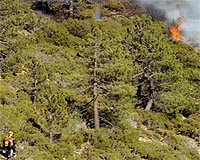| . |  |
. |
Washington DC (SPX) Jul 29, 2009 By 2055, wildfires in the western United States could scorch about 50 percent more land than they do now, causing a sharp decline in the region's air quality, a new study predicts. This potential leap in destructiveness and pollution--mainly from an increase in wildfire frequency--is forecast by computer models calculating impacts of moderate global warming on western U.S. wildfire patterns and atmospheric chemistry. As fires and smoke increase, the health of people living in the region could suffer, the study's authors say. Atmospheric scientists at Harvard University who conducted the research report that their models show the greatest future increases in area burned (75 to 175 percent) in the forests of the Pacific Northwest and the Rocky Mountains. And, because of extra burning throughout the western U.S., one important type of smoke particle--organic carbon aerosols--would increase, on average, by about 40 percent during the roughly half-century period, they add. Previous studies by other researchers have probed the links between climate change and fire severity in the West and elsewhere. However, the Harvard study represents the first attempt to quantify the impact of future wildfires on the air we breathe, says Jennifer Logan of Harvard's School of Engineering and Applied Sciences (SEAS), who led the research. A report on the results has been accepted for publication in the Journal of Geophysical Research - Atmospheres, a journal of the American Geophysical Union (AGU). "Warmer temperatures can dry out underbrush, leading to a more serious conflagration once a fire is started by lightning or human activity," notes Logan. "Because smoke and other particles from fires adversely affect air quality, an increase in wildfires could have large impacts on human health." To conduct the research, the team first examined a 25-year record of observed meteorology and fire statistics to identify those meteorological factors that could best predict area burned for each ecosystem in the western United States. To see how these meteorological factors would change in the future, the researchers then next ran a global climate model out to 2055, following a scenario of future greenhouse gas emissions known as A1B. This scenario, one of several devised by the United Nations Intergovernmental Panel on Climate Change, describes a future world with rapid economic growth and balanced energy generation from fossil and alternative fuels. Relative to the other scenarios, it leads to a moderate warming of the earth's average surface temperature, about 1.6 degrees Celsius (3 degrees Fahrenheit) by 2050. "By hypothesizing that the same relationships between meteorology and area burned still hold in the future, we then could predict wildfire activity and emissions from 2000 to the 2050's," explains Logan. As a last step, the researchers used an atmospheric chemistry model to understand how the change in wildfire activity would affect air quality. This model, combining their predictions of areas burned with projected 2050s meteorology data, shows the quantities of emissions and the fates of smoke and other particles released by the future wildfires. The resulting diminished air quality could lead to smoggier skies and adversely affect those suffering from lung and heart conditions such as asthma and chronic bronchitis. Such consequences are a "climate penalty" that diminishes the effectiveness of efforts to reduce air pollution across the United States, the researchers say. Their new work could help policymakers gauge how severe that penalty might become. In addition, the study underscores the need for a vigorous fire management plan. The team next plans to focus on future wildfires and air quality over the densely populated areas in California and in the southwest United States. Logan's collaborators include Research Associate Loretta Mickley and former postdocs Dominick Spracklen and Rynda Hudman, all at SEAS. Grants from the STAR (Science to Achieve Results) program of the National Center for Environmental Research of the U.S. Environmental Protection Agency and from NASA supported this research.
Share This Article With Planet Earth
Related Links Harvard University Forest and Wild Fires - News, Science and Technology
 Europe beats back wildfires, fears revival
Europe beats back wildfires, fears revivalMadrid (AFP) July 27, 2009 Firefighters gained the upper hand against deadly wildfires across southern Europe but warned on Monday that the flames could flare up again with sizzling temperatures and strong winds forecast. In France, Italy and Spain -- the worst affected countries -- most of the blazes were extinguished or under control although firefighters remained on alert. Spain's Interior Minister Alfredo ... read more |
|
| The content herein, unless otherwise known to be public domain, are Copyright 1995-2009 - SpaceDaily. AFP and UPI Wire Stories are copyright Agence France-Presse and United Press International. ESA Portal Reports are copyright European Space Agency. All NASA sourced material is public domain. Additional copyrights may apply in whole or part to other bona fide parties. Advertising does not imply endorsement,agreement or approval of any opinions, statements or information provided by SpaceDaily on any Web page published or hosted by SpaceDaily. Privacy Statement |